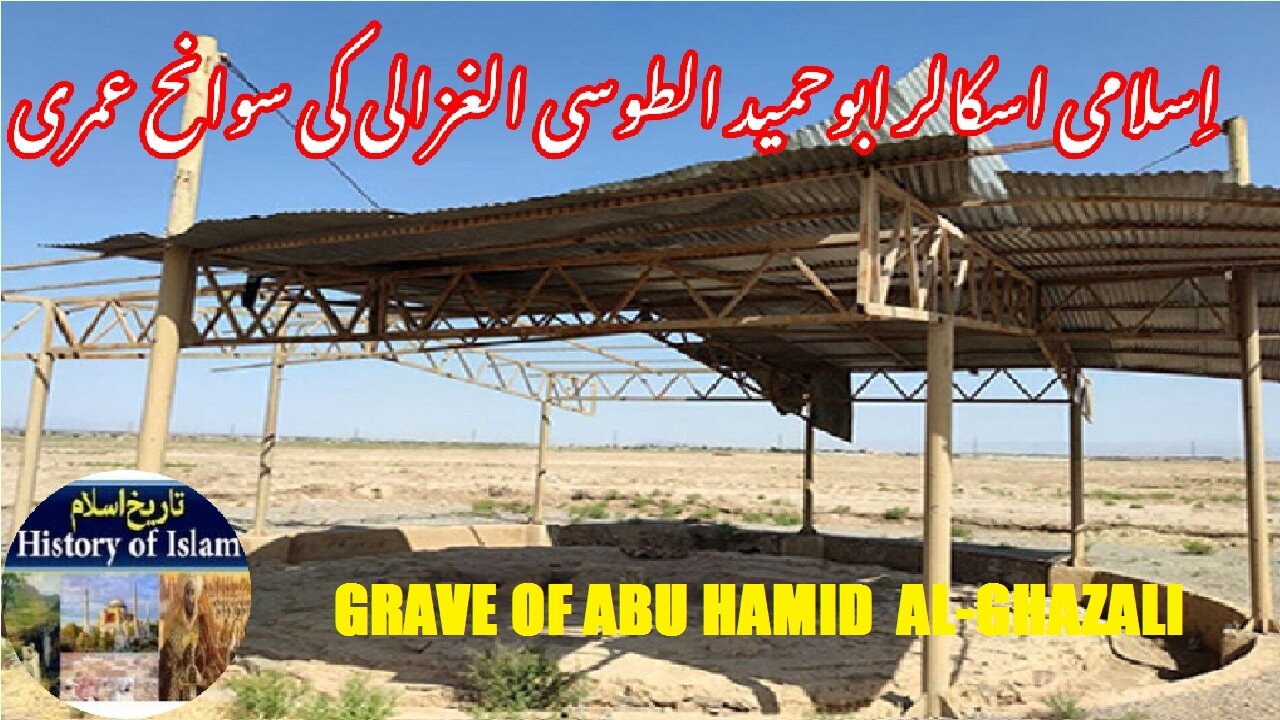Premium Only Content

Biography of Abu Hmid Muhammad al-Ghazali and tomb | ابو حمید محمد الطوسی الغزالی کی سوانح اور مقبرہ
@islamichistory813 #KhwajaNasir #SpiritualLegacy #SufiWisdom #AbuHmidMuhammad #alTusiyy #alGhazali
Biography of Abu Hmid Muhammad al-Tusiyy al-Ghazali and tomb
Dekhti Aankhooon aur sountay kaanoon ko Asslamoalaikum, In this islamic informative video, we are presenting the biography of Khwaja Nasir ad-Din Ubayd Allah al-Ahrar, a revered spiritual scholar known for his profound insights into Sufism. The narrative covers his formative years, significant teachings, and the historical context in which he operated. By examining his contributions to spiritual literature and practice, we aim to highlight the importance of his work in the modern spiritual landscape.
Abu Hmid Muhammad ibn Muhammad al-Tusiyy al-Ghazali known commonly as Al-Ghazali known in Medieval Europe by the Latinized Algazelus or Algazel, was a Persian Sunni Muslim polymath. He is known as one of the most prominent and influential jurisconsults, legal theoreticians, muftis, philosophers, theologians, logicians and mystics in Islamic history.
Al-Ghazali was born in c.?1058 in Tus, then part of the Seljuk Empire. He was a Muslim scholar, law specialist, rationalist, and spiritualist of Persian descent. He was born in Tabaran, a town in the district of Tus, Khorasan (now part of Iran), not long after Seljuks entered Baghdad and ended Shia Buyid Amir al-umaras. This marked the start of Seljuk influence over Caliphate. While the Seljuk dynasty's influence grew, Abu Suleiman Dawud Chaghri Beg married his daughter, Arslan Khatun Khadija[53] to caliph al-Qa'im in 1056.
A posthumous tradition, the authenticity of which has been questioned in recent scholarship, is that his father died in poverty and left the young al-Ghazali and his brother Ahmad to the care of a Sufi. Al-Ghazali's contemporary and first biographer, 'Abd al-Ghafir al-Farisi, records merely that al-Ghazali began to receive instruction in fiqh (Islamic jurisprudence) from Ahmad al-Radhakani, a local teacher and Abu ali Farmadi, a Naqshbandi sufi from Tus. He later studied under al-Juwayni, the distinguished jurist and theologian and "the most outstanding Muslim scholar of his time," in Nishapur, perhaps after a period of study in Gurgan. After al-Juwayni's death in 1085, al-Ghazali departed from Nishapur and joined the court of Nizam al-Mulk, the powerful vizier of the Seljuk empire, which was likely centered in Isfahan. After bestowing upon him the titles of "Brilliance of the Religion" and "Eminence among the Religious Leaders", Nizam al-Mulk advanced al-Ghazali in July 1091 to the "most prestigious and most challenging" professorial position at the time: the Nizamiyya madrasa in Baghdad.
He underwent a spiritual crisis in 1095, which some speculate was brought on by clinical hysteria, abandoned his career and left Baghdad on the pretext of going on pilgrimage to Mecca. Making arrangements for his family, he disposed of his wealth and adopted an ascetic lifestyle. According to biographer Duncan B. Macdonald, the purpose of abstaining from scholastic work was to confront the spiritual experience and more ordinary understanding of "the Word and the Traditions." After some time in Damascus and Jerusalem, with a visit to Medina and Mecca in 1096, he returned to Tus to spend the next several years in uzla (seclusion). The seclusion consisted in abstaining from teaching at state-sponsored institutions, but he continued to publish, receive visitors and teach in the zawiya (private madrasa) and khanqah (Sufi lodge) that he had built.
Fakhr al-Mulk, grand vizier to Ahmad Sanjar, pressed al-Ghazali to return to the Nizamiyya in Nishapur. Al-Ghazali reluctantly capitulated in 1106, fearing rightly that he and his teachings would meet with resistance and controversy. He later returned to Tus and declined an invitation in 1110 from the grand vizier of the Seljuq Sultan Muhammad I to return to Baghdad. He died on 19 December 1111. According to 'Abd al-Ghafir al-Farisi, he had several daughters but no sons.
The tomb of Abu Hamid Muhammad Ibn Muhammad Al Ghazali—who died at the age of 53 in 1111 CE—still awaits the glory and respect it deserves. Two years ago mentioned in a magazine, That foundations of the tomb of Al Ghazali, originally octagonally built with Seljuk architectural features, give an idea of what this place was like once. This place probably did not survive the destruction by the invading Mongols, who had passed through these lands in the first half of the 13th century. The ruined state of the place stands testimony to the violent times.
However, the tomb today appears to have been abandoned. Barring a few patches of ugly plasterwork to hide the cracks, nothing has been done to restore this archaeological treasure.
The neglect is all the more surprising since Iran is known to put great efforts in preserving graves with historical significance.
According to a statement by the Iranian Foundations and Charities Institution, there are 8,167 imamzada (sons or grandsons of the Twelve Imams) shrines in Iran today. According to some sources , many shrines touted as Imamzada shrines are believed to have emerged after the 1979 Iranian Revolution.
Ghazali's tomb is not alone in this regard. It must be said that Persian scholar Nizam al Mulk's tomb is also not in good condition, although it was better than Ghazali's. As it is known, these two names, who are people from the same geography, have an exceptional place in the history of Islamic civilization.
The influence of Nizam al Mulk on Islamic state philosophy and the influence of Ghazali on thought is indisputable.
Centuries ago, Al Ghazali had profoundly said: “Dear friend, your heart is a polished mirror. You must wipe it clean of the veil of dust that has gathered upon it, because it is destined to reflect the light of divine secrets.”
if the dust and cobwebs are removed from his tomb, it will perhaps reflect Al Ghazali’s life and work on a world which needs his teachings more than ever.
So sisters brothers friends and elders, tomorow we will be described Biography of Sufi Scholar Mansour al-Hallaj. Allah hafiz
=============================
-
 4:31:10
4:31:10
I_Came_With_Fire_Podcast
16 hours agoMy EURO Divorce | HOGG with a side of PAC | Foreign FUNDS Fudged
30.1K2 -
 37:44
37:44
Glenn Greenwald
13 hours agoGlenn On Tearing Down the Military Industrial Complex, Exposing Pro-Israel Indoctrination, and More | SYSTEM UPDATE #411
106K120 -
 4:04:20
4:04:20
Nerdrotic
12 hours ago $49.47 earnedAmazon Takes 007! Hollywood is Lost, Disney Cancels WHO? | Friday Night Tights 342 /w ItsAGundam
167K39 -
 43:27
43:27
Tucker Carlson
11 hours agoRay Dalio: America’s Hidden Civil War, and the Race to Beat China in Tech, Economics, and Academia
161K184 -
 56:56
56:56
Candace Show Podcast
12 hours agoEXCLUSIVE: Taylor Swift Will Be Deposed. | Candace Ep 150
187K147 -
 1:03:52
1:03:52
IsaacButterfield
9 hours ago $4.34 earnedRepublican Vs 25 Transgender Activists | Jewish Outrage | Lizzo Loses All the Weight
55.7K14 -
 1:10:23
1:10:23
Edge of Wonder
13 hours agoChinese Biochips Hacking Minds? Quantum Control & Journey Song Mandela Effect
79.3K9 -
 2:15:46
2:15:46
Quite Frankly
16 hours ago"Ghosts, Robotics, and OBE's" ft. Dr. Albert Taylor 2/21/25
73.4K18 -
 55:52
55:52
LFA TV
1 day agoMaking Germany Great Again | TRUMPET DAILY 2.21.25 7PM
49.1K9 -
 1:52:26
1:52:26
2 MIKES LIVE
11 hours ago2 MIKES LIVE #183 Open Mike Friday with Hannah Faulkner and Adelia Kirchner!
35.8K